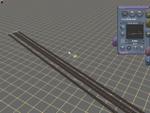| |
| Articles |
Tutorials
| To-Scale Switches and Slips (part.1), by Dr. Norbert Aust (Switchdoc) |
| Read | Write comments: 9 |
Posted Sun May 04 2003 3:09pm |
Page:
1
2
3
4
5
6
7
8
|
By the way: here we have one very big advantage of the approach in tracklaying used in Trainz: There is no need for too much of accuracy here. Just the visual impression should be okay - and we need not too much of precision to satisfy this one. Theres no need to fumble around placing track to fractions of inches' precision because otherwise you would not be able to close the final gap as you would have to if you warked with fixed pieces of track.
Fig.03 shows the above mentioned tracks of traffic in place.

fig.03
On placing the trackpieces do not be too tight with the length. In Trainz it is (a little bit) easier to shorten a piece of track that is too long than to prolong one that is too short. And the railway enthusiast with eyes spoilt by model railroading has yet to get used to the distances and lengths of tracks that you find in real life. Even a small stationi in a rural area with only a small number of tracks will easily build up to a length of 1000 meters between the switches furthest apart. For any kind of centralstation well equipped to arrange and rearrange freight and passenger trains 2000 meters and more is not unusual (that would be about 25 meters in HO Scale !!). All this with the relatively short trains we have around here, 600m for freight trains, 350m for passenger trains. I guess with the milelong trains in America or Australia there will still be more length to any station.
2) Placing of connecting tracks
According to the dimensions of the type of switch we want to use we place the connecting tracks, especially observing the angles involved.
Lets begin in the west: Both of the mainline tracks shall be connected to the siding for slower consists to await passing. Trains going in there will have quite considerable speed when passing the switches and if trains not so heavily loaded accelerate in going back to main, the last of the cars will have some speed too when passing the switch. Thats why we select switches and slips 500 - 1 : 12 for this connection.
The ratio of 1 : 12 indicates, that distance to the branch will increase by one meter if we move 12 meters further down the line (if the branch would be prolonged in straight direction). with this denomination of angles the design procedure is very simple...
|
|
|
|

